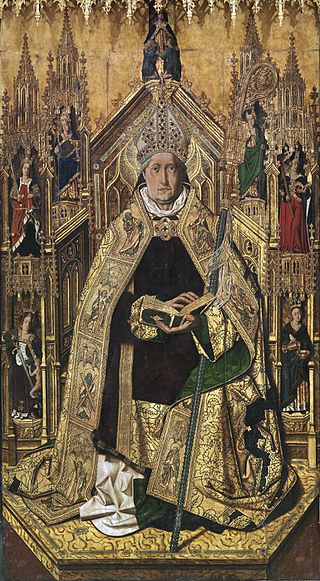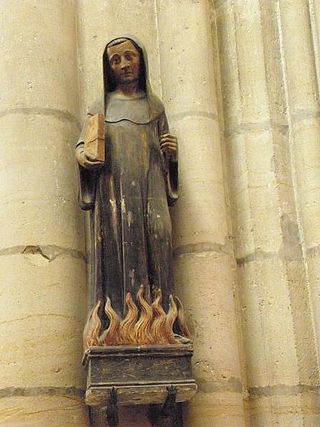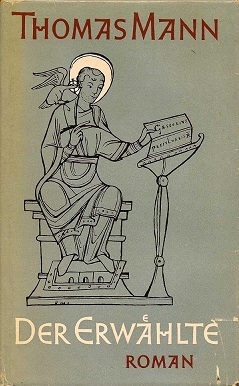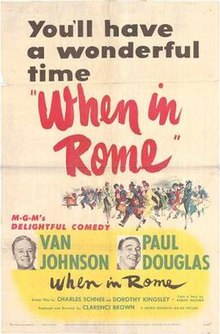
Abbot is an ecclesiastical title given to the male head of a monastery in various Western religious traditions, including Christianity. The office may also be given as an honorary title to a clergyman who is not the head of a monastery. The female equivalent is abbess.

Bernard of Clairvaux, O. Cist., venerated as Saint Bernard, was an abbot, mystic, co-founder of the Knights Templar, and a major leader in the reformation of the Benedictine Order through the nascent Cistercian Order.

Pope Victor III, was the head of the Catholic Church and ruler of the Papal States from 24 May 1086 to his death. He was the successor of Pope Gregory VII, yet his pontificate is far less notable than his time as Desiderius, the great abbot of Monte Cassino.

Moses the Black, also known as Moses the Strong, Moses the Robber, and Moses the Ethiopian, was an ascetic monk and priest in Egypt in the fourth century AD, and a Desert Father. He is highly venerated in the Eastern Orthodox Church and the Oriental Orthodox Church. According to stories about him, he converted from a life of crime to one of asceticism. He is mentioned in Sozomen's Ecclesiastical History, written about 70 years after Moses's death.

Odo of Cluny was the second abbot of Cluny. He enacted various reforms in the Cluniac system of France and Italy. He is venerated as a saint by the Catholic and Eastern Orthodox Churches. His feast day is 18 November.

Christian monasticism is the devotional practice of Christians who live ascetic and typically cloistered lives that are dedicated to Christian worship. It began to develop early in the history of the Christian Church, modeled upon scriptural examples and ideals, including those in the Old Testament, but was not mandated as an institution in the scriptures. It has come to be regulated by religious rules and, in modern times, the Canon law of the respective Christian denominations that have forms of monastic living. Those living the monastic life are known by the generic terms monks (men) and nuns (women). The word monk originated from the Greek μοναχός, itself from μόνος meaning 'alone'.

Hugh O'Flaherty was an Irish Catholic priest, a senior official of the Roman Curia and a significant figure in the Catholic resistance to Nazism. During the Second World War, O'Flaherty was responsible for saving 6,500 Allied soldiers and Jews. His ability to evade the traps set by the German Gestapo and Sicherheitsdienst (SD) earned him the nickname "The Scarlet Pimpernel of the Vatican".

Saint Ceolfrid was an Anglo-Saxon Christian abbot and saint. He is best known as the warden of Bede from the age of seven until his death in 716. He was the Abbot of Monkwearmouth-Jarrow Abbey, and a major contributor to the project to produce the Codex Amiatinus Bible. He died in Burgundy while en route to deliver a copy of the codex to Pope Gregory II in Rome.

Sep. 12 - Eastern Orthodox liturgical calendar - Sep. 14

The Sicilian is a novel by American author Mario Puzo. Published in 1984 by Random House Publishing Group (ISBN 0-671-43564-7), it is based on the life of Sicilian bandit Salvatore Giuliano. It is set in the same universe as Puzo's most famous work, The Godfather (1969), and contains characters from The Godfather. It is regarded as The Godfather's literary sequel and is the second book in The Godfather novel series. It was adapted into a film in 1987, though all Godfather references were removed for copyright reasons in the film adaptation.

Nimatullah Kassab, O.L.M., also known as "Al-Hardini" in reference to his birth village, was a Lebanese monk, priest and scholar of the Maronite Church. He has been declared a saint by the Catholic Church.

Odilo of Cluny was the fifth Benedictine Abbot of Cluny, succeeding Mayeul and holding the post for around 54 years. During his tenure Cluny became the most important monastery in western Europe. Odilo actively worked to reform the monastic practices not only at Cluny, but at other Benedictine houses. He also promoted the Truce of God whereby military hostilities were temporarily suspended at certain times for ostensibly religious reasons. Odilo encouraged the formal practice of personal consecration to Mary. He established All Souls' Day in Cluny and its monasteries as the annual commemoration to pray for all the faithful departed. The practice was soon adopted throughout the whole Western church. He was lifelong friends with William of Dijon, another Cluniac abbot and reformer.
Majolus of Cluny was the fourth abbot of Cluny. Majolus was very active in reforming individual communities of monks and canons; first, as a personal commission, requested and authorized by the Emperor or other nobility. Later, he found it more effective to affiliate some of the foundations to the motherhouse at Cluny to lessen the likelihood of later relapse.
The Order of Clerics Regular Minor, commonly known as the Caracciolini or Adorno Fathers, is a Roman Catholic religious order of priests and brothers founded by Francis Caracciolo, Augustine Adorno, and Fabrizio Caracciolo in 1588 at Villa Santa Maria, Abruzzo. Belonging to the family of Clerics Regular, its members desired to sanctify themselves and the People of God by imitating in their lives the Paschal Mystery of Christ. Its motto is Ad Maiorem Dei Resurgentis Gloriam, "For the Greater Glory of the Risen God". The members of the congregation use the acronym CRM . after their names.

The Holy Sinner is a German novel written by Thomas Mann. Published in 1951, it is based on the medieval verse epic Gregorius written by the German Minnesinger Hartmann von Aue. The book explores a subject that fascinated Thomas Mann to the end of his life – the origins of evil and evil's connection with magic. Here Mann uses a medieval legend about "the exceeding mercy of God and the birth of the blessed Pope Gregory" as he used the biblical account of Joseph as the basis for Joseph and His Brothers, illuminating with his ironic sensibility the notion of original sin and transcendence of evil.

Winibald was abbot of the Benedictine double monastery of Heidenheim am Hahnenkamm. Traditionally, he is called the brother of Willibald and Walpurga.
Gregorio Cortese, born Giovanni Andrea Cortese was an Italian cardinal and monastic reformer.
Hildebrand Gregori, O.S.B. Silv.,, was an Italian Benedictine monk, who served as the Abbot General of the Sylvestrine congregation of the Order. He was instrumental in the care of the many orphans left in the City of Rome after the destruction of World War II. The cause for his beatification has been accepted by the Holy See, due to which he is honored as Venerable.
Ivan Ziatyk was a Ukrainian Catholic priest, Redemptorist, and lecturer, considered to be a martyr by the Catholic Church.

Il commissario di ferro (transl. The Iron Commissioner is a 1978 Italian poliziottesco film directed by Stelvio Massi.















